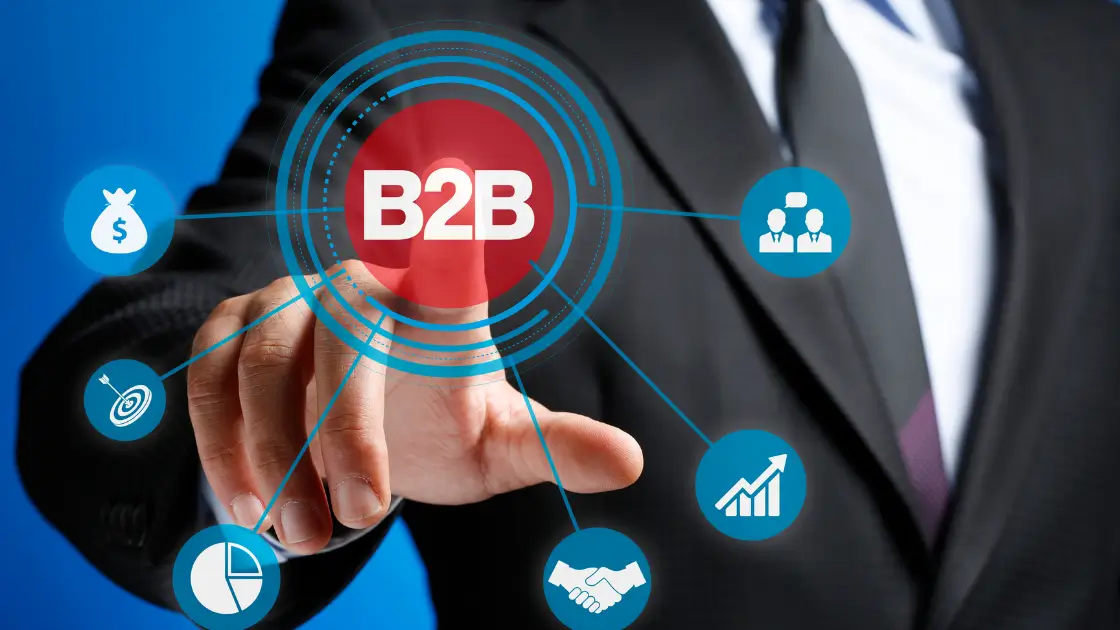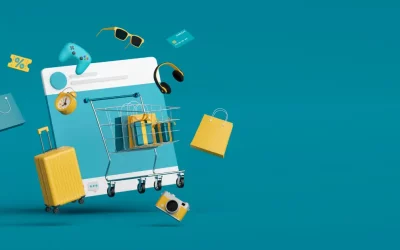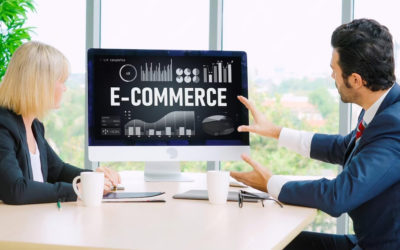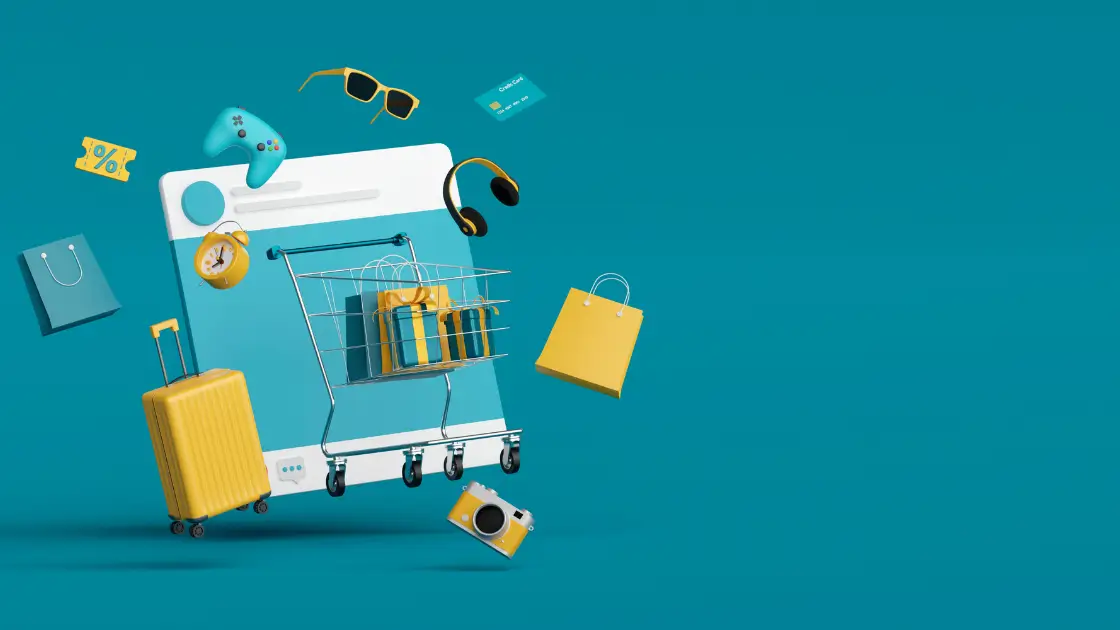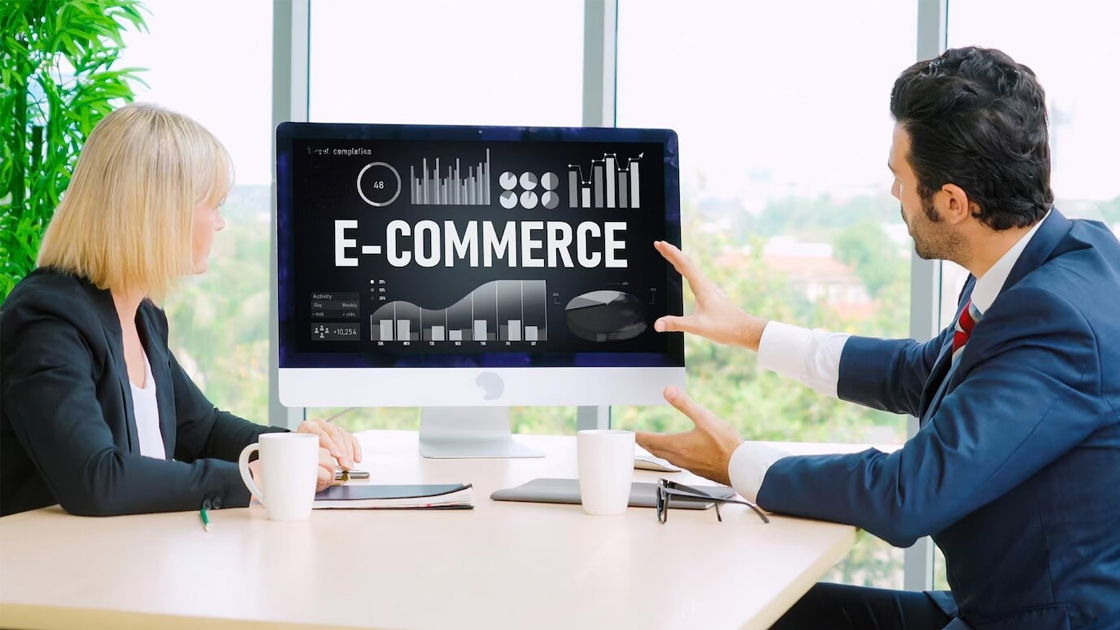The market size for B2B eCommerce is growing, going from around $7,432 billion in 2022 to a projected $36,107 billion in 2031 [1]. At the same time, for many businesses that sell to other companies, B2B eCommerce may be an untapped prospect because it can take significant time, energy, and resources to establish an effective eCommerce portal. However, once you understand the different kinds of B2B eCommerce, it is easier to decide which type you need and figure out the best solution.
Key Insights:
- Business-to-business (B2B) eCommerce uses the internet and texting to sell products and services to other businesses.
- The most common types of B2B ecommerce include B2B2C, wholesale, manufacturing, and distribution companies.
- To gauge the success of your B2B ecommerce strategy, you can use metrics such as conversion rate, customer satisfaction stats, and cart abandonment rates.
- LANSA’s Commerce Edition makes it easy to set up a B2B eCommerce solution from the ground up or integrate a new system with your existing ERP.
eCommerce Opportunities for B2B Businesses
eCommerce for B2B has quickly grown from a novelty marketing strategy to a mainstream technique. For some businesses, incorporating eCommerce as they sell to other companies may be necessary just to keep up with the competition. A recent study revealed that the B2B eCommerce market is projected to reach over $2 trillion by the time 2024 wraps up [4].
Some of the top drivers for the growth of eCommerce as a B2B tool include:
- Convenience for B2B customers. They can use mobile apps and your website to make purchases and have questions answered no matter where they are and 24/7
- Low-work, low-cost transactions. You don’t need to employ sales staff to process every sale, which can save you money on hiring additional workers as your business grows or during peak selling periods.
- Greater exposure to remote markets. An eCommerce strategy exposes you to customers from all over the globe, making it far easier to sell to companies in other countries, states, and provinces.
How Does B2B eCommerce Work?
Wondering how B2B eCommerce works? Business-to-business (B2B) eCommerce involves using the internet or other electronic tools, such as texting, to sell products and services to other businesses. This makes it different from business-to-customer (B2C), where you sell your offering directly to individual consumers.
What is B2B eCommerce from a transactional perspective? Typically, in a B2B eCommerce transaction, a business sets up an online sales portal, and other businesses access it to make purchases. In this way, B2B makes it more convenient for buyers to get the products or services they need while making it simpler for the supplier to update its inventory and market to other businesses.
B2B eCommerce also enables more convenient transactions, especially because many online portals are available via mobile devices. With just a few clicks, a buyer can make a purchase without leaving their home, office, or vehicle.
Types of B2B eCommerce
B2B and eCommerce go hand in hand. Even though there are countless different kinds of transactions in the business-to-business eCommerce market, they tend to fall under one or more of a few categories. You can use the following types of B2B eCommerce to narrow down the kinds of transactions your company needs to perform.
B2B2C
In a business-to-business-to-consumer (B2B2C) transaction, you have a manufacturer or wholesaler that sends its products to another business, which then gets the products to a consumer. In this setup, one business partners with another to make sure its products get to the consumer. For instance, by using an affiliate marketing approach, you use the affiliate to get your offering to customers who visit links from the affiliate’s website.
Another common B2B2C example is when restaurants or grocery stores partner with delivery services to get their food into the hands of consumers. In this way, a B2B2C arrangement uses another business to facilitate a sale to individual people without the other business having to purchase the product beforehand.
Wholesale
In wholesale B2B eCommerce, you sell your product to a business that buys it at a lower price. The business then sells your product to individual consumers. Therefore, the end objective is more about getting products into the hands of consumers than earning sales from another business. After all, if consumers do not ultimately purchase from the business you are selling to, that business cannot afford to continue buying from you.
For example, a wholesaler may list its products on Alibaba, offering bulk discounts for purchases of 100 or more. The wholesaler aims to find a business that can sell its products to consumers. If the business they partner with is successful in retailing these goods to customers, they will continue placing orders with the wholesaler.
Wholesaling has been around for a long time, but transactions used to happen over the phone, through email, or via spreadsheets and order forms. With wholesale B2B eCommerce, on the other hand, everything happens through the wholesaler’s online platform. The business they are selling to simply goes to the website and purchases the products they want to retail to customers.
Manufacturers
Manufacturer B2B eCommerce enables them to sell their goods directly to other businesses and use sales data to decide production levels and schedules. In this model, a manufacturer produces parts or complete products and lists them for sale on their website. Then, another manufacturer or retail business buys the items or components and either sells them to a customer or uses them to build their own products.
For example, a computer chip manufacturer can list the different types of chips it builds on its eCommerce platform. Then, a computer manufacturer can purchase the chips they need to build desktops or laptops, combining the chips with other components, such as screens, keyboards, or peripheral devices.
Distributors
eCommerce for distributors involves a manufacturer selling its products to a distribution business, which then resells those products to a retailer or individual people. The sale between the manufacturer and the distributor happens via an eCommerce portal.
Often, when the distributor resells the product to a consumer or business, they also use an eCommerce platform. For example, a manufacturer may build components and sell them to a distributor that uses Amazon to get the goods to customers. Take a manufacturer that builds e-bikes. A distribution company goes to the wholesaler’s eCommerce platform and purchases the e-bikes. The distributor then sells the e-bikes on their Amazon sales page to individual consumers.
Getting Started With eCommerce as a B2B Business
The key to getting your e-commerce system off the ground is to grasp the unique dynamics of your target market and use that to plan strategically and choose the right platform. This enables you to launch with operational clarity. And with the right platform, you also get a system for measuring and managing performance.
Conducting Thorough Market Research
Performing market research as you get started with B2B eCommerce is similar to the research you’d perform before launching a regular business. You need to dig into:
- What your customers need and expect
- What your competition is already doing when it comes to eCommerce tools
- Industry trends, especially when it comes to the kinds of eCommerce tools that are the most successful
- Gaps in the eCommerce market that your business can fill. For instance, do your competitors have a mobile app, or do they only sell via their website or a third-party site like Amazon? By offering more choices, you can gain an edge
Developing a Robust Business Plan and Digital Marketing Strategy
Developing your business plan involves outlining the goals of your eCommerce system as well as concretely describing the value this will bring to your business. In addition, you need to draw up a systematic operational plan. This needs to include the tools you use, who manages them, and how you’ll evaluate their performance.
Since eCommerce can reach such a wide range of customers, your digital marketing strategy should be just as diverse. This means several channels, including social media, content marketing, and email marketing. For some companies, it makes sense to also use pay-per-click (PPC) marketing and search engine optimization (SEO), especially if your website is your primary eCommerce portal.
Choosing and Setting Up the Right E-Commerce Platform
This phase is crucial because this is where you identify the eCommerce features that best suit your business and then see which platforms fit the bill. As you consider your options, you’ll find that some are highly customizable, while others may lack customization but may be easier to work with.
It’s also common for eCommerce solutions to vary when it comes to their ability to integrate with other business systems. This can be a deal-breaker—or -maker—if you depend on a system that you need to integrate with, such as an ERP or CRM.
However, regardless of your industry and business model, you’ll want to choose and configure an eCommerce platform that can:
- Support complicated B2B transactions.
- Scale with your business, especially if you have to add products or process many more transactions quickly.
- Flex with your business, which makes customization a top priority.
- Provide user-friendly features, making it easy for non-technical users to work with.
LANSA Commerce Edition checks all of the above boxes, giving you the power to customize your storefront, allow customers to view their carts, empower users to choose items from your catalog and go straight to their cart, and easily adjust product details. LANSA Commerce Edition also comes with marketing tools, analytics and reporting, and a content management system—all in an easy-to-use, low-code solution.
Establishing Clear Operational Guidelines
Your operational guidelines provide the architecture for managing inventory, processing orders, and making sure customers get the products they need on time. Customer satisfaction should be paramount, so you also want to establish a customer service system. For some businesses, an in-depth FAQ section and how-to videos can take much of the burden off the shoulders of customer service staff.
Depending on the types of products you’re selling, you may also have to incorporate a refund, return, and restocking system into your operational infrastructure.
Defining Key Performance Indicators
Some performance indicators are part and parcel of any sales system, such as sales volume, customer lifetime value, and average order volume. But for a B2B eCommerce system, you also want to include metrics like:
- Conversion rate, which tells you the percentage of site visitors or app users that end up as paying customers.
- Customer satisfaction, which you can monitor using feedback, ratings, and surveys.
- Cart abandonment rates, which tell you how often customers add an item to their carts without going through with the purchase.
B2B eCommerce: Best Practices
Here are some opportunities and B2B eCommerce best practices that other successful companies use.
Give B2B eCommerce the B2C Treatment
A business customer may have some technological savvy, but this does not mean they do not enjoy the same conveniences that individual consumers have grown accustomed to.
Some B2C features that work well in B2B include:
- Using on-site search capabilities
- Including high-resolution images and videos
- Using reviews and ratings to provide social proof
- Providing multiple shipping options
- Giving buyers the option to update their orders after making an initial purchase
- Personalizing what you offer buyers based on previous purchases
- Optimizing your eCommerce storefront design for easy viewing on mobile devices
- Providing an online catalog to enable easy browsing
- Integrating your eCommerce platform with your inventory system for real-time availability
- Incorporating links to live chat or phone support
For example, much of the look, feel, and workflows on Amazon’s B2B e-commerce portal mirror those of its B2C solution [2]. You will find high-quality images, personalized buying based on previous purchases, and easy-to-use searching.
Educate and Outshine Your Competitors
When you provide comprehensive educational resources and guides regarding how to use your products or services, you make your offering easier to use and establish yourself as an authority in your industry. This is good for both:
- Brand identity. By showcasing industry knowledge and providing insights into how your solution solves problems, you earn the respect and trust of those in your business sector.
- Fostering sales. Business buyers often have to do extensive research to make sure they purchase just the right product. Therefore, when you teach them how to use your offering and showcase its benefits and most helpful features, you essentially do the research for them. This makes it much easier for them to commit to a purchase.
Customer education often centers on providing free content to help users get comfortable using your product or service. This is particularly helpful in B2B eCommerce because your customers frequently need to successfully use your offering to increase revenue or support operations.
Facilitate the Migration From Offline to Online
Many businesses are eager to transition from a traditional buying structure to an eCommerce platform but do not know how to do so. If you have an eCommerce platform, this is a golden opportunity for your company because you can guide them through this unfamiliar territory, earning their trust and business along the way.
For example, they may not understand how to pay their invoices or set up delivery preferences. By providing business customers with straightforward tutorials and an informative FAQ section, you can address these and other questions.
Amazon is a good example of a company that guides business customers through the transition from offline to online buying. On its Amazon Business Help page, a business customer can find all the information they need to feel comfortable working with Amazon Business, including how to pay invoices, set up delivery options, request refunds, and get started with a business account.
Utilize Technology for Customer Challenges
When you use technology to overcome customer challenges, you make it easier for customers to purchase through your B2B eCommerce platform. For instance, you can set up systems that simplify and automate processes while minimizing errors business customers may otherwise make. You can also make sure your B2B eCommerce platform is easy to navigate, which streamlines the buying process.
Using technology to overcome customer challenges has become common across the B2B eCommerce space. For example, many companies include auto-fill options that automatically input a returning customer’s address or credit card information. This reduces the chances of incorrect payment details preventing a successful purchase.
Take Advantage of Loyalty Programs
From a B2B perspective, loyalty programs focus on encouraging a smooth revenue stream through repeat, needs-based purchases. Unlike most individual consumers, who may buy a product only once, B2B customers often need to buy the same or similar products again and again to replenish their stock. By setting up loyalty programs, you can earn these customers’ business via discounts that benefit their bottom lines.
For instance, you can give each business customer an account that comes with automatically calculated discounts based on their monthly, quarterly, or yearly sales volume.
For some businesses, a subscription-based loyalty program works best for both the buyer and seller. For the seller, a subscription provides guaranteed revenue each month, regardless of how much the customer purchases. Also, when a business client signs up for a subscription, they demonstrate a long-term commitment to doing business with your company.
A subscription-based loyalty program enables purchasers to lock in significant discounts. They can use this to predict overhead expenses and structure their annual budgets.
You can also offer special advantages for your B2B eCommerce subscribers. For example, FedEx offers a number of special features to its business subscribers. A business subscriber can get sustainability insights and service alerts. If a business customer wants to create a sustainability report for stakeholders, it can log into its FedEx account and print out a report that shows the impact of its shipping on its carbon footprint [3].
Align Business Processes and Teams to Scale
It is common for organizations to end up with inefficient processes due to silos or infrastructures that prevent people from working together. To make sure your teams are properly aligned, you should:
- Examine your existing organizational structure. This involves building an organizational chart and then reconsidering whether it is still effective, especially as you consider a shift to B2B from traditional selling. Your current structure may not support a B2B setup. You may have too many people focusing on person-to-person sales or not enough shipping and fulfillment staff to manage the number of sales your B2B system will generate.
- Re-examine how resources support roles. Each person in your organization needs specific resources to do their job. By re-examining who has access to which resources, you make it easier for your employees to meet and exceed expectations. In the context of B2B, this may involve providing your staff with the software they need to update listings or change product details as needed.
- Outsource specific roles, if necessary. In some cases, you may need to outsource much of your B2B eCommerce management. For example, it might be best to hire an outside company to design your platform and manage your listings.
Engage Customers Across Channels
By engaging customers via multiple channels, you give them more opportunities to make purchases on their own terms. Some common B2B eCommerce channels include:
- A B2B solution embedded in your website
- A standalone, online B2B platform that operates separately from your website
- A mobile-friendly B2B portal
- Mobile apps customers can install on their devices and then use to make purchases
- B2B texting options that enable customers to text order details directly to your system
- Messaging platforms that have ordering features in them, such as WhatsApp or Facebook Marketplace
Using some or all of these channels can be critical to your B2B strategy because it gives customers convenient access to the purchasing process. For instance, those who make purchases while in the office may appreciate a B2B solution embedded in your website’s standalone B2B portal.
Those who spend significant time on the road, working remotely, or in the field may appreciate a mobile app, texting, or messaging platform they can access via their personal devices.
For instance, shipping company Maersk uses multiple channels to enable its business customers to set up shipments. Customers have access to an online portal, Maersk’s sales department, and its support system. Maersk also provides a way to identify which local office is closest to your business so you can reach out to them directly.
Infographic 2: The Different Sizes eCommerce Businesses
- Enterprise: Typically over 1,000 employees with large complex eCommerce operations, often with global, region-specific marketing strategies
- Mid-market: Between 100 and 1,000 employees, with flexible eCommerce solutions that vary according to target market and sales volume
- Small: Less than 100 employees, typically using simpler eCommerce ecosystems that incorporate personalization and one-on-one customer service
Leverage Pricing Automation
Pricing automation enables your B2B solution to adjust prices according to individual customers, customer categories, purchase types, or purchase volume.
For instance, suppose you manufacture car parts and use a B2B eCommerce platform to sell to auto manufacturers. When someone orders 300 or more camshafts, you can have the platform automatically apply a 15% discount.
You also have the option of automating price adjustments based on geographical location.
Adjusting pricing for negotiated deals involves tailoring what you charge based on the buyer. For instance, your B2B platform can make it easier to:
- Create multiple price lists according to how individual business customers make purchases in volume.
- Assign specific percentage discounts or fixed pricing to individual businesses.
- Establish maximum, minimum, and quantity increments for specific products.
- Automatically sending orders of drafts for review to make it easier to negotiate special deals.
- Automatically integrating rewards based on loyalty programs.
One example of pricing automation is the NBA League pass. This is an app that provides access to NBA games and other content. The amount you have to pay varies according to your location. People in the United States, for example, pay one monthly subscription fee, but those in some other countries pay different amounts. If you log into their site from Belize, for example, the price drops to around half what you would pay in the US League Pass’s system detects your location based on your IP address and automatically adjusts your pricing.
Design with Usability in Mind
Usability is a key factor because it results in more efficient experiences for your customers. Usability factors that deliver value include:
- Websites and pages that load quickly. Creating fast-loading pages often involves reducing the sizes of images and videos.
- Seamless checkout processes. You can use “Buy Now” buttons or auto-fill address information to make the checkout process smoother.
- eCommerce pages that provide buying recommendations based on products currently in a shopping cart. For example, if a component needs a certain kind of fastener to make it easier to attach, you can automatically include this fastener once that product has been loaded into the shopping cart.
Sometimes, usability hinges on simplifying the customer’s buying journey. IBM, for example, provides business users with a page that offers clickable deals. Each tab outlines how much customers save at the very top and then goes deeper into which kinds of customers qualify underneath. You can then quickly click through to pricing plans and choose “Buy Now.” You do not have to log in until you have already chosen the plan you want and are ready to make your purchase.
Generate Leads with Customers in Mind
Your lead generation process should focus on customer needs instead of promoting your company. This goes against traditional lead generation methodologies because it puts your brand second to what your customers want.
For example, if you have a B2B eCommerce solution on your website, you may include a series of blogs designed to generate leads. The topic of each blog should focus on ways of solving:
- Problems the customer already knows they have.
- Problems the customer may not be aware of.
Using this technique, you prioritize solving customer challenges. This supports the authority of your brand because it shows that you understand how to address obstacles your target market has to overcome.
Converting a lead to a buying customer may involve a relatively brief CTA that points them toward your company’s solution and a link to your eCommerce portal. In some cases, it may be sufficient to simply demonstrate your knowledge of how to solve the customer’s problem and allow them to conclude for themselves that your offering is the best choice.
Either way, by making your lead generation system supplier-agnostic, you put your customer—rather than your brand—front and center.
This works well for businesses of all sizes. For instance, White Knight Pest Control in Texas provides detailed blogs that describe steps homeowners can take to get rid of pests in their homes. The company doesn’t mention itself as an option until the very end of the blog, and the CTA is very simple: “For more information about X in Y location, get in touch with the (pest) experts at White Knight Pest Control.” In this way, they spend far more time giving customers knowledge than pitching their offerings.
Forge Strategic Partnerships
Often, the best way to grow is to leverage partnerships with other companies. This tactic allows your company to benefit from the foothold another organization has already established with your target market.
To illustrate, suppose you run a food and beverage company and want to boost your B2B eCommerce sales. You could choose to partner with a catering company that serves corporations in your target markets. You can offer them a significant discount on food and beverages they purchase every time they use your eCommerce solution. As a result, your sales benefit from the business the caterer has already earned.
Collaborating with complementary businesses allows you to extend your reach and tap into new markets. This was one of the goals when airline catering company Mainline Aviation partnered with SAS Scandinavian Airlines. Without having to invest significant funds in appealing to Scandinavian passengers, Mainline Aviation was able to tap into that demographic by inking a deal with SAS.
Ease the Transaction Process
It is important to remember that, like individuals, no two business customers are the same—even if they have similar offerings. Therefore, to ensure a personalized buying experience, it is important to customize each client’s interaction with your eCommerce solution.
One way to do this is to set up product catalogs specific to individual customers. You can use an eCommerce platform that enables you to adjust which products are shown based on the customer’s visit to the site.
Your eCommerce solution can also empower you to adjust pricing based on which customer is using it and customize your incentive programs. All of these combine to create a smooth transaction process.
Convenience should be the driving factor in your B2B eCommerce solution’s payment processes as well. For example, some businesses require minimum order quantities as part of the sales approval process accepting payment. You can automate this in your B2B solution.
When it comes time for the customer to complete their purchase, your platform should present them with a diverse rate of clearly presented options. If possible, it is best to accept a range of payment types, such as:
- Electronic payments like PayPal.
- Direct dispersals from bank accounts.
- Credit card payments.
B2B eCommerce Myths & Misconceptions
Sometimes, organizations are reluctant to adopt a B2B eCommerce solution due to common myths. Here are some misconceptions as well as the realities they sometimes hide.
You are Not Already Engaging in B2B
Many companies may misconstrue their business model as being B2C when, in reality, they are already using a B2B sales system. For example, all of the following are included under the B2B umbrella:
- Wholesaling
- Distributing to large retailers or retail chains
- Selling your products or services to schools, businesses, or nonprofits
- Selling to resellers
In addition, you do not have to commit to being either B2B or B2C because you can sell to both businesses and customers using the same platform. All you have to do is optimize each customer’s interaction with the platform based on whether they are a business or an individual.
B2B Customers Would Rather Order Offline
Some may assume that business purchasers prefer traditional methods of buying due to using these channels for years or decades. However, the convenience of a B2B platform makes buying easier for people of all ages and professional backgrounds. In addition, as the younger generation assumes roles as buyers, it is incumbent upon businesses to provide experiences they are familiar with. The straightforward workflow of typical online purchases, such as those experienced on Amazon or eBay, should inspire the design of your eCommerce solution.
Given these features, it is not surprising that online shopping has been increasing at a rate of 26.55% year over year [7].
An eCommerce Solution Needs to Have Transparent Pricing
Despite the fact that many B2C eCommerce portals display pricing upfront, this is not necessarily an expectation in the B2B space. Business customers understand that your clients can get different prices based on order volume or customer loyalty, so they may not expect to see pricing information on your eCommerce pages.
At the same time, you can also be transparent regarding how customers can earn better pricing by describing, at a high level, the kind of buying behavior you reward with lower prices.
Ordering Online Is Cold and Impersonal
While it may seem that person-to-person sales paves the way for deeper relationships, this is not always the case. This is especially true when it comes to millennials and Gen X buyers, who may be used to straightforward digital purchasing processes.
Ordering over the phone, for example, may feel incredibly inconvenient because it takes a long time, and you need to call until you get an answer. In effect, your customer may wonder, “Why do I have to spend 15 minutes on the phone when their competition lets me buy online in a few moments?”
You Cannot Customize Orders With an eCommerce Solution
Order customization using B2B eCommerce may be even easier than doing it over the phone or in person. For example, you can customize price adjustments based on the user who logs in.
You can also enable buyers to make adjustments to their orders within a certain amount of time after placing them. Further, if you manually review orders before sending them to your fulfillment team, you may be able to extend the window for adjusting orders to several days.
For example, with LANSA Commerce Edition, you can enable buyers to customize their orders however they’d like. you also have the power to customize how you approve and process orders.
Customers Do Not Want to Make Large Purchases Online
Even though making purchases online used to be seen as extremely risky, the prevalence of safe, secure ordering processes has dispelled this belief. Many people prefer ordering even very expensive items online, including everything from high-end jewelry to vehicles.
This may be why many companies offer online purchase guarantees, where the buyer can get a refund or purchase insurance that covers damage or delivery issues.
Whether it’s Mark Cuban spending $40 million on a private jet online or more modest purchases, business owners have no problem pulling the trigger while shopping online [6].
Benefits of Using a B2B eCommerce Platform
Although the benefits of using a B2B eCommerce platform vary from one business to another, there are some common advantages that many organizations enjoy. The following list of benefits can be helpful as you decide how to design your solution because you can use them as benchmarks to gauge value and ROI.
Enhanced Supplier and Customer Management
When you run an eCommerce platform, you can manage all facets of the customer buying process in one place. This includes collecting customer information, fulfilling orders, and even controlling inventory. You also have the option to automate the sales process for your business customers, making their purchasing system more efficient.
Providing personalized, streamlined customer experiences supports longer-term business relationships, and a B2B eCommerce platform makes this much easier. Each time a customer logs in, they can see purchase recommendations, feeds that automatically update according to their information, and pricing customized according to their needs.
Upsell/Cross-sell to Existing Customers
The upsell or cross-selling process can be awkward and difficult over the phone or in person. However, using your B2B eCommerce solution to upsell or cross-sell creates a more comfortable dynamic, especially for your customers.
For instance, when you present them with a buying recommendation, they can take as much time as they would like to mull it over, run it by decision-makers, or factor it into their existing budget.
By contrast, in-person upselling and cross-selling often put a buyer in an uncomfortable position because they may feel pressured to make a decision right there on the spot. A B2B eCommerce platform eliminates this challenge.
Expansion Possibilities
The expansion potential that a B2B eCommerce platform introduces can be significant, especially when it comes to attracting customers from different geographic locations. Many businesses may find themselves pigeonholed and restricted to a localized customer base because they typically sell face-to-face or over the phone. But with an eCommerce system, you can access people all over the globe.
Similarly, eCommerce makes it easier to market to a wider selection of potential buyers. Using social media marketing, for example, you can target businesses according to location, their products or services, and even the kinds of businesses they like or follow on a social platform. With all of these options, expanding is far easier than it would be using traditional selling methods.
Enhanced Data Analytics
In traditional sales, you can only collect data if a salesperson takes notes or manually inputs information in a customer relationship management (CRM) system. On the other hand, with B2B eCommerce, your system can automatically collect data, which you can use to analyze and make decisions.
For example, you can set it up to collect information regarding:
- The buying habits of each of your customers
- The number of sales you generate over specific time periods, such as every month
- Customer contact information, including phone numbers, addresses, email addresses, and social media information
- The number of page visits, including the pages each customer navigates to
- The time spent on each page, as well as how much time a customer spent on a particular product’s page
The LANSA Commerce Edition Advantage
The LANSA Commerce Edition provides you with a secure site that enables you to maintain your storefront, updating it as you wish. You also have the ability to add, remove, and adjust products and their information, as well as make adjustments to the content you use in your selling process.
Access Controls for Improved Security and Simplified Workflows
To enhance security and usability, LANSA Commerce Edition gives you the power to restrict user access so people can only edit sections of the site if they absolutely need to. By using LANSA Composer Edition to limit page access, you also streamline your employees’ workflows, making it easier for them to know where to click by removing unnecessary options.
Straightforward Data Analytics
Another benefit of LANSA Composer Edition is it enables you to set up all pages for Google Analytics tracking. With this feature, you have the data to make strategic decisions regarding which products or listings to adjust, improve, or eliminate.
The Ability to Design Multiple Storefronts
You can use a single implementation of LANSA Commerce Edition to design multiple storefronts. This gives you power over all elements of your online branding strategy in connection with your eCommerce solution.
Comprehensive Integration Across Your Digital Ecosystem
With LANSA Commerce Edition, you have the freedom to integrate data from multiple ERPs and CRMs, which can save time and improve accuracy.
For example, you can integrate data from your inventory management system directly into your e-commerce solution.
Transaction Security
LANSA Commerce Edition meets PCI DSS compliance requirements and uses Secure Socket Layer (SSL) to encrypt data in transmission. With LANSA Commerce Edition, you do not have to store cardholder data locally because the system leaves payment data storage up to accredited payment providers.
B2B eCommerce Examples
The following examples showcase the effectiveness of using a B2B eCommerce solution.
DEMCO
DEMCO, a library supply, equipment, and furniture provider in North America and Europe, used LANSA Commerce Edition to set up customer- and supplier-facing sites. DEMCO began with a site built by its internet services provider (ISP), but the company wanted to bring its web development process in-house. This allowed greater control over their online presence.
They used LANSA Commerce Edition to build three eCommerce sites for a subsidiary brand in the UK. Soon after they launched, DEMCO saw a 100% increase in the amount of business conducted over the web.
Carole Fabrics
Carole Fabrics, a company in Augusta, GA, that manufactures draperies, window coverings, bedspreads, and other home decorations, was struggling with customer orders. They found that more than 40% of their custom orders could not be made unless their staff called the decorator for more information. This resulted in slow delivery times and inaccurate order information.
Instead of building a website from scratch, Carole Fabrics used LANSA Commerce Edition. The system enabled Carole Fabrics to track orders, inquire about online stock, and place fabric orders. They also implemented a question-and-answer script that helped them eliminate issues regarding style, measurements, lining specifications, size considerations, and other variations between orders.
BAS Insurance
BAS Insurance, which provides insurance, administrative, and marketing services in the UK, had to host almost 20 branded travel insurance sites and another 10 sites for member benefit offerings.
Also, BAS launched a new product called AllClear Travel Insurance and was using a call center to handle all customer screening, quotes, and inquiries. Even though this had been working, they needed a web-enabled product in order to scale up.
After evaluating multiple options, BAS Insurance went with LANSA Commerce Edition. Using this solution, the company created a system that managed the quoting and buying process and a complicated medical screening system. Thanks to the ease of use that LANSA Commerce Edition provides, BAS was able to take its site live in only two months.
Nobilis
Nobilis, a manufacturer and designer of carpets, fabrics, furniture, and wallpaper, had thousands of different products to manage. The company also had around 200 partners worldwide who needed access to product information.
By using LANSA Commerce Edition, the company was able to set up an online catalog for importers, distributors, and subsidiaries. This gave them a solution that enabled access to deeper product details and technical descriptions so that their business clients could make better ordering decisions.
LANSA Commerce Edition gave Nobilis a more secure solution, which alleviated stress related to potential internet attacks. The company also saved when it came to hardware because there were no additional purchases necessary, and they could use an existing iSeries server to host their development environment.
The Future of B2B eCommerce
B2B eCommerce trends are pointing north. The industry is poised to enjoy steady growth over the next few years, with a projected swell of 24.8% between 2022 and 2026 in sales on B2B eCommerce sites in the US. Sales on B2B sites are expected to reach over $2.4 trillion in 2026 [5].
To position your organization to take advantage of the rise of B2B eCommerce, you can depend on LANSA Commerce Edition. Thanks to its rich feature set and the fast development it enables, LANSA Commerce Edition is a leading solution for B2B companies that incorporate eCommerce in their strategies.
As highly integrated, full-featured eCommerce solutions become increasingly essential in the competitive landscape, you can rely on LANSA Commerce Edition to give you a flexible, dependable, secure eCommerce solution. Reach out to us today to see how LANSA can empower your eCommerce system.
References
- Straits Research, “B2B eCommerce Market Share, Size and Forecast to 2031.” https://straitsresearch.com/report/b2b-eCommerce-market#:~:text=Market+Overview,19.2%25+from+2023+to+2031.
- “Amazon Business Prime.” https://www.amazon.com/businessprime.
- “Sustainability Insights.” https://sustainability.dataworks.fedex.com/.
- Digital Commerce 360, Internet Retailer, “2024 B2B Market and Customer Experience Report I Digital Commerce 360,” Digital Commerce 360, Feb. 06, 2024. https://www.digitalcommerce360.com/product/b2b-market-and-customer-experience-report/
- E. Cramer-Flood, “US B2B ecommerce forecast 2022–2026,” EMARKETER, Oct. 18, 2022. https://www.emarketer.com/content/us-b2b-ecommerce-forecast-2022-2026
- M. Finlay and O. Memon, “Did You Know Mark Cuban’s Gulfstream V Set A World Record For The Biggest Online Purchase?,” Simple Flying, Feb. 26, 2024. https://simpleflying.com/mark-cuban-gulfstream-v-biggest-online-purchase/
- SkyQuest Technology Consulting Pvt. Ltd., “Global e-Commerce market to hit sales of $58.74 trillion by 2028 | E-commerce market has come a long way, still need to overcome some challenges,” GlobeNewswire News Room, Oct. 31, 2022. https://www.globenewswire.com/news-release/2022/10/31/2544834/0/en/Global-e-Commerce-Market-to-Hit-Sales-of-58-74-Trillion-By-2028-E-commerce-Market-Has-Come-a-Long-Way-Still-Need-to-Overcome-Some-Challenges.html


